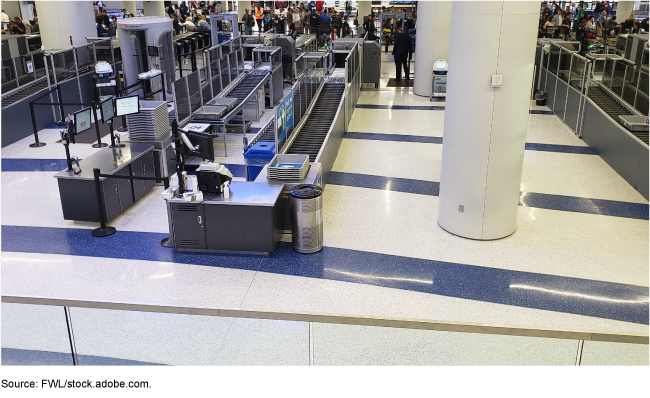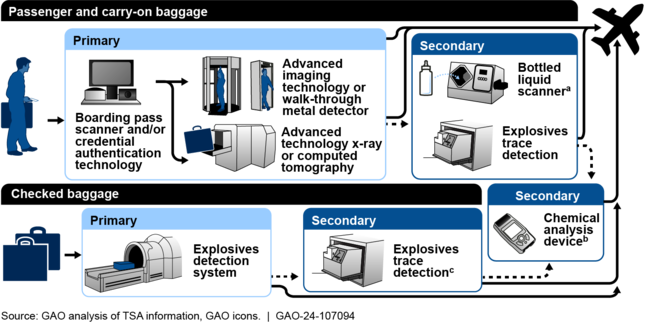Aviation Security: TSA Could Better Ensure Detection and Assess the Potential for Discrimination in Its Screening Technologies
Fast Facts
This testimony discusses our prior work on Transportation Security Administration screening technologies. The technologies help screen passengers and their baggage for explosives or prohibited items. TSA must continually assess if its screening operations are effective.
But TSA has had issues with ensuring that the technologies consistently meet detection standards after being put into service. And advanced imaging technology scans can result in certain people—like people wearing religious headwear—being referred for extra screening more often than others.
TSA is working to address our prior recommendations. We continue to monitor its progress.

Highlights
What GAO Found
In December 2019, GAO reported that the performance of technologies the Transportation Security Administration (TSA) uses to screen passengers and baggage at airports can degrade over time. However, TSA does not ensure that such technologies continue to meet detection requirements after deployment to airports.
Transportation Security Administration (TSA) Technologies Used for Checkpoint and Checked Baggage Screening

TSA certifies technologies to ensure they meet requirements before deployment, and its officers are to regularly calibrate deployed technologies to demonstrate they are minimally operational. However, neither of these actions ensures that technologies continue to meet requirements after deployment. In 2015 and 2016, the Department of Homeland Security (DHS) tested a sample of deployed explosives trace detection and bottled liquid scanner units and found that some no longer met detection requirements. GAO recommended that TSA develop and implement a process to ensure technologies continue to meet detection requirements after deployment. TSA began requiring reviews of technologies after deployment in 2020 and is working to update its policy. TSA has also begun to conduct reviews and report on the results.
In November 2022, GAO reported that TSA officials at four selected airports and representatives from seven selected stakeholder organizations, such as the National Center for Transgender Equality and the Sikh Coalition, stated that the use of advanced imaging technology can result in certain passengers being referred for additional screening more frequently than others. These include transgender passengers and those who wear religious headwear or have disabilities. GAO recommended that TSA (1) collect data on referrals for additional screening, and (2) assess the extent to which its screening practices comply with agency non-discrimination policies. According to TSA officials, the agency has taken steps to collect data on such referrals, including the cause of additional screening, and plans to assess the data to inform the development and use of advance imaging technology.
Why GAO Did This Study
TSA employs passenger and baggage screening technologies to mitigate the threat of terrorism. TSA has faced challenges ensuring these technologies consistently meet detection requirements. The agency has also faced allegations that some of its screening practices, such as the use of advanced imaging technology, may refer certain passengers more frequently to additional screening.
This statement discusses TSA's efforts to (1) ensure passenger and baggage screening technologies continue to meet detection requirements after deployment and (2) assess the extent to which its use of advanced imaging technology refers certain passengers to additional screening more often than others.
This statement is based primarily on reports GAO issued in December 2019 and November 2022 on detection requirements for TSA screening technologies (GAO-20-56) and TSA's efforts to ensure its passenger screening practices do not result in discrimination (GAO-23-105201). To report on actions taken to address recommendations, GAO assessed implementation reports and reviewed agency documents and responses.
Recommendations
GAO made a total of nine recommendations in the December 2019 and November 2022 reports. DHS concurred with all nine recommendations. Seven remain open. However, TSA has taken steps to implement them, including the four recommendations to address the issues discussed in detail in this statement.
